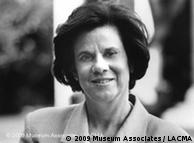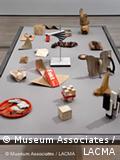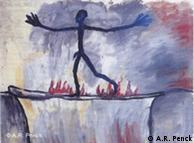
Art of Two Germanys/Cold War Cultures
January 25, 2009–April 19, 2009 | BCAM
For East and West Germany during the Cold War, the creation of art and its reception and theorization were closely linked to their respective political systems: the Western liberal democracy of the Federal Republic of Germany (FRG) and the Eastern communist dictatorship of the German Democratic Republic (GDR). Reacting against the legacy of Nazism, both Germanys revived pre-World War II national artistic traditions. Yet they developed distinctive versions of modern and postmodern art—at times in accord with their political cultures, at other times in opposition to them. By tracing the political, cultural, and theoretical discourses during the Cold War in the East and West German art worlds, Art of Two Germanys reveals the complex and richly varied roles that conventional art, new media, new art forms, popular culture, and contemporary art exhibitions played in the establishment of their art in the postwar era.
Art of Two Germanys is the first special exhibition to go on view in
LACMA’s new Renzo Piano designed-building, the Broad Contemporary Art Museum (BCAM). Divided into four chronological sections, the exhibition includes approximately 300 paintings, sculptures, photographs, multiples, videos, installations, and books, by 120 artists. The show features large-scale installations and recreations of major works by Hans Haacke, Heinz Mack, Sigmar Polke, Raffael Rheinsberg, Gerhard Richter, and Dieter Roth,
as well as a number of videos and performance-based works. After LACMA, the exhibition will travel to Germanisches Nationalmuseum, Nürnberg (May 23–September 6, 2009), and Deutsches Historisches Museum, Berlin (October 3, 2009–January 10, 2010).
Curated by Stephanie Barron, Senior Curator of Modern Art, LACMA, and co-curator Dr. Eckhart Gillen, Kulturprojekte Berlin GmbH.
This exhibition was organized by the Los Angeles County Museum of Art in cooperation with Kulturprojekte Berlin GmbH. It was made possible in part by an award from the National Endowment for the Arts and the Foreign Office of the Federal Republic of Germany. Additional support was provided by LACMA's Art Museum Council. The international tour has been funded by the German Federal Cultural Foundation and Stiftung Deutsche Klassenlotterie.
Art | 30.01.2009
Top LA Curator Breaks the East-West Divide in German Art
The exhibition "Art of Two Germanys/Cold War Cultures" runs through April 19, 2009 at the Los Angeles County Museum of Art (LACMA). It will then travel to Germany, where it will be shown at the Germanisches Nationalmuseum in Nuremberg (May 23-Sept. 6, 2009) and the Deutsches Historisches Museum in Berlin (Oct. 3-Jan. 10, 2010). Click on the picture gallery below to see some of the works from the exhibition.
DW-WORLD: What is the exhibition's aim?
Stephanie Barron: The purpose of the exhibition is really to look freshly with a distance of twenty years and of being outside Germany at the remarkable range of art created during the Cold War in both Germanys.
We want to look freshly at some of the more familiar ideas about how art has been characterized from this period. It's been primarily characterized by painting -- which is one reason why the exhibition also has so many examples of sculpture, photography, installation, video, documentation of performance and artists' books.
We also try to examine the notion that so much of post-war German art is really expressionist in nature. By looking at multiple threads, I think we make that argument. We also wanted to look closely at works by both East and West German artists together, wherever possible in the same room, and not try to isolate them.
 Bildunterschrift: Großansicht des Bildes mit der Bildunterschrift: Barron has been a curator at LACMA since 1976
Bildunterschrift: Großansicht des Bildes mit der Bildunterschrift: Barron has been a curator at LACMA since 1976
It sounds like you're interested in changing the way people think about art from the Cold War period.
I think we are, though I don't think this is necessarily what we started out to do. It's the result of good investigation. Coming at this project as someone in the United States, I don’t bring the same baggage that I would if I were a curator in Germany -- for better or for worse.
I was happy to be able to work with German colleagues on the exhibition. But keeping in mind how this was going to work for a US audience was always very important. I think I wasn't burdened by many of the expectations that (Germans) would have coming to the exhibition.
What are those expectations?
I'll give you an example. When we install an exhibition, every work of art has a label. It says the artist's name, where they were born, where they died, or where they lived and where they were active. In essence, you have to read the labels to find out who is East and who is West.
For many in our audience, who are equally unfamiliar with Konrad Lueg or (Eugen) Schoeneberg as they are with (Werner) Tuebke or (Willi) Sitte they come freshly looking at it as art -- not with any preconceptions about East as one thing and West as something else. I find that very liberating and very fresh.
The exhibition is going to Germany, where it will actually spend more time than in California. Do you think it will be more challenging there with a German audience?
I don't know. One of the things I've noticed over 30 years of doing exhibitions and traveling quite a bit in Germany is that the demographics in Germany have changed. I wonder if people coming to an exhibition like this, depending on their generation, bring the same expectations or the same baggage to it. But I would suspect that a younger generation -- people in their twenties -- might look differently at this show than people in their sixties.
Artistically speaking, can we talk about a "unified" Germany, even 20 years after the fall of the Berlin Wall?
This exhibition ends in 1989 and I don't think it's appropriate in the context of this one to make sweeping observations about the post-Wall period.
But I do think that we try to challenge the preconceptions. The second room of the exhibition brings together on one wall examples of Socialist Realism from the 1950s, while on another wall there's informal and abstraction -- (Emil) Schumacher, KO Goetz. And yet right in the middle is a large table filled with these marvelous, small cultural exercises by Hermann Gloeckner from Dresden, who totally confounds any expectations or stereotypes.
So I think we've tried to find artists who are not necessarily always the most expected.
 Bildunterschrift: Großansicht des Bildes mit der Bildunterschrift: Barron says she enjoys the works of Hermann Gloeckner
Bildunterschrift: Großansicht des Bildes mit der Bildunterschrift: Barron says she enjoys the works of Hermann Gloeckner
Do you think that, based on this exhibition which ends with 1989, conclusions can be made about the relationship between art and politics in general?
I think that it's hard to look at German art of the 20th century and not think about the intersections with politics. Certainly, art of the 90s -- internationally -- is just a much more global experience.
When I go to Berlin now, I can just as easily meet someone from London as from Los Angeles or Budapest or Berlin or Hamburg. It's a much more international situation, particularly in Berlin. I find that very exciting, but I think the "Germanness" has become less identifiable than perhaps it was 25 years ago.
How did your personal interest in German art develop?
As an undergraduate and graduate student, I studied French art, like most art historians in the United States. At Columbia University, when I was there, we still had the last gasp of the emigres, but I was studying French and contemporary art.
When I moved to Los Angeles in the mid-1970s, I found that there was this great library of German Expressionism and a great print and book collection here. Being away from New York, before the Ghetty was available with its great library, being able to do original resource in LA was an opportunity I didn't want to pass up. It was also a topic that hadn't been as well mined by others.
Do you have a favorite piece that you stop and look at each time you walk through the exhibition?
When I walk through and see the works of Hermann Gloeckner, I have to say that I still get a chill. I remember seeing the archives in Dresden and being shown these works and thinking, these are absolutely amazing -- I really wanted to show these and bring them to Los Angeles.

沒有留言:
張貼留言